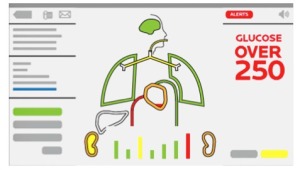OR decision support system greatly improves lung ventilation management, study finds
by
Lauren Dubinsky, Senior Reporter | January 26, 2018

AlertWatchOR
New research published in Anesthesiology demonstrated that a new decision support system for the operating room significantly improves lung ventilation management.
“The algorithms used in the system are evidence-based, supported by peer-reviewed literature, and have been informed by feedback from clinicians practicing at the front lines,” Dr. Sachin Kheterpal, lead author and associate professor at the University of Michigan Medical School, told HCB News. “This process ensures the software isn't just technology for technology's sake, but novel improvements that are known to impact care.”
The system under investigation is a commercially available product called AlertWatchOR. It’s in use at several other U.S. hospitals and integrates with a variety of commercially available monitoring systems and several major EHR vendors.
It displays real-time blood pressure, ventilation and heart rate patient data on a single platform. The physician anesthesiologists get a schematic organ system view of the patient’s beating heart and breathing lungs as well as digital text and audible alerts when a patient’s blood pressure is dangerously low.
“With modern processing technology, hundreds of data streams are integrated on a powerful centralized server at each hospital,” said Kheterpal. “The results of those algorithms are then presented on a screen in each operating room or other clinical area.”
The study, which included 26,769 patients, found that when physician anesthesiologists use AlertWatchOR there was a meaningful improvement in the management of lung ventilation during surgery. The researchers also found a reduction in charges and a decrease in length of stay by one day, compared to cases that did not use AlertWatchOR.
However, it had no effect on the rates of heart attack and renal failure. Kheterpal explained that his team only looked at all-cause mortality, acute kidney injury and myocardial ischemia, which are relatively uncommon events that are difficult to address with any intervention.
“Next, the intraoperative period is important, but it is one part of an overall process that impacts clinical outcomes,” he added. “For example, optimal intraoperative care enabled by our decision support system could be overwhelmed by hypotension or excessive fluid administration postoperatively."
In an accompanying editorial, Dr. Daniel Sessler of Cleveland Clinic underscored the importance of formally validating decision support systems based on clinical outcomes before making them mainstream. He’s concerned that systems in development will include a hundred or more alerts.
"Presumably many will be helpful, but others may not. It would, therefore, seem reasonable to expect most decision support systems and alerts to undergo formal testing, just as we would expect any drug or other device to be properly validated. I congratulate Kheterpal et al. on formally testing their system,” he wrote.
|
|
|
You Must Be Logged In To Post A Comment
|
